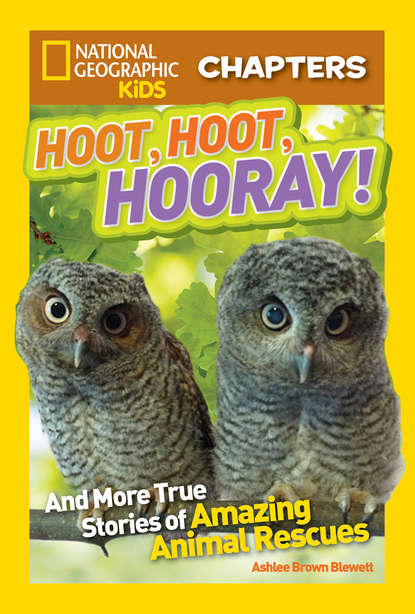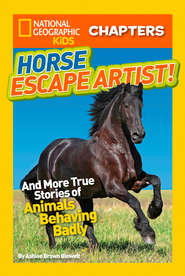По всем вопросам обращайтесь на: info@litportal.ru
(©) 2003-2024.
✖
National Geographic Kids Chapters: Hoot, Hoot, Hooray!: And More True Stories of Amazing Animal Rescues
Автор
Год написания книги
2019
Настройки чтения
Размер шрифта
Высота строк
Поля
PAUL AND BABE: Hoot, Hoot, Hooray! (#u11786d0a-d378-519c-b76a-401bb12794e1)
Chapter 1: Timber! (#u01243ebe-e95d-56fb-9fa4-a7e4e36a4593)
Chapter 2: Raptor Rescue (#ue364cc42-d7e8-5711-81d3-088c96df5a52)
Chapter 3: Hoot, Hoot, Hooray! (#litres_trial_promo)
ZONGOLONI: Operation Elephant Rescue! (#litres_trial_promo)
Chapter 1: Brave Little Calf (#litres_trial_promo)
Chapter 2: Learning to Trust (#litres_trial_promo)
Chapter 3: Wild Again (#litres_trial_promo)
HEAVENLY: Brave Bear! (#litres_trial_promo)
Chapter 1: Mountaintop Rescue (#litres_trial_promo)
Chapter 2: Time to Heal (#litres_trial_promo)
Chapter 3: A Forever Home (#litres_trial_promo)
DON’T MISS! (#litres_trial_promo)
Chapter 1: Pouch Pet (#litres_trial_promo)
More Information (#litres_trial_promo)
Author’s Note (#litres_trial_promo)
Dedication (#litres_trial_promo)
Credits (#litres_trial_promo)
Acknowledgments (#litres_trial_promo)
Baby owl Paul stands beside his sister, Babe. Eastern screech-owls can be red, like Paul, or gray, like Babe. (photo credit p01.1 (#litres_trial_promo))
When Homer Kuhn found these little baby owls, their eyes were still closed. (photo credit p01.2 (#litres_trial_promo))
May 1, 2013 New Creek, West Virginia, U.S.A.
It was a sunny day, without a cloud in the sky. Birds chirped, squirrels barked, hawks screamed, and a family of deer ate grass near the edge of the woods. Woodcutter Homer Kuhn (sounds like COON) had just finished sawing the base of a dried-out tree.
“Timber!” Homer called.
The tree hit the ground. Thud!
Homer looped a long, heavy chain around the log. His brother, Willie, pulled the log out of the forest using a large machine that looks like a tractor, called a skidder. As the log slid past Homer, a flash of white caught his eye. He thought he saw two snowballs lying on the ground. But Homer knew that they couldn’t be snowballs. It was 80°F (26.5°C) outside.
Homer says, “I thought, what in the world is lying white like that in the middle of the woods?” He walked over to investigate. Lying in the dirt were two baby eastern screech-owls.
Homer scooped up the baby owls, or owlets, in his hand. They looked like two fluffy marshmallows. Peep, peep! the owlets called. They must have fallen out of a hole in the log, Homer thought.
Some birds build nests. Not screech-owls. Instead, they nest inside tree cavities (sounds like KAV-uh-tees). These are holes made by other animals, like woodpeckers. Usually, the mother owl looks after the babies while the father owl hunts for food to bring back to the family.
Homer searched the area for the owlets’ parents. He looked inside the holes of other trees. But he found no parent owls. Homer knew that if he left the owlets in the woods with no home and no parents, they would die. He wrapped the babies in an old T-shirt. Then he pulled his cell phone out of his pocket and called the one person he knew would help.
“Hello,” said Mrs. Tammi Kuhn.
“Hi, Mom,” Homer answered. “We have something.”
“Is it squirrels again?” Mrs. Kuhn asked.
“No, we found two baby owls this time,” Homer said.
“Oh my!” said Mrs. Kuhn. “I’ll be right there.”
Mrs. Kuhn was used to getting calls like this from her sons. Homer and Willie work for a logging company. They spend most days in the woods, cutting down trees. Then they sell the logs they collect to a nearby sawmill to be cut into boards and sold as lumber. Sometimes, in the woods, the brothers find baby animals.
Owls live on every continent except Antarctica. They come in many shapes and sizes. The Eurasian (sounds like yur-AY-zhun) eagle-owl can grow to more than two feet (0.6 m) tall. It can weigh up to ten pounds (4.5 kg). The elf owl only grows to around six inches (15 cm) tall. It weighs less than half as much as this book. Owls’ feathers help them blend into their habitats. The snowy owl’s thick white feathers hide it from enemies in the frozen Arctic. And the gray- and rust-colored feathers of a screech-owl make it seem to disappear next to a tree.
Eurasian eagle-owl (photo credit 1.1 (#litres_trial_promo))
“If we find baby squirrels or baby raccoons, we try to rescue them,” Homer says. “We find a lot of squirrels.” When the boys spot these animals, they call their mother for help. “She raises them until they are old enough to care for themselves,” says Homer. Then Mrs. Kuhn returns the animals to the wild.
Mrs. Kuhn has raised and released many squirrels over the years. But screech-owls were different. She had never cared for screech-owls. In fact, it is illegal to raise them in West Virginia. But these babies needed help.
Mrs. Kuhn got in her car and drove to the edge of the woods. “I really didn’t know what to do with baby screech-owls, but I didn’t want them to die,” says Mrs. Kuhn. She called everyone she knew, trying to find a rescue center that could take them. Meanwhile, she drove the owlets back to her house. She put them in a box with a heating pad to keep them warm, and she did her best to feed them.
Did You Know?
There are more than 200 species (sounds like SPEE-sheez), or kinds, of owls.
In the wild, baby screech-owls stay in the nest for about one month. Then they begin to learn how to fly and hunt. After that, the parents continue to protect and feed their young owls for two or three more months, until they can hunt on their own. But the baby owls’ eyes were still closed. They were less than a week old.
Owls are carnivores (sounds like CAR-nuh-vors). They eat meat. The owlets’ parents would have fed the babies insects and small mammals, like mice. All Mrs. Kuhn had was frozen hamburger and deer meat. She thawed the meat and cut it into small chunks. Then she used tweezers to feed the meat to the “baby hooters,” as she called the owlets. She called them this because of the sound adult screech-owls make: Hoot, hoot!
Did You Know?
Different kinds of owls make different noises. Owls can purr, chirp, bark, whistle, screech, whinny, and—of course—hoot.
The hungry owlets snatched the meat from the tweezers and swallowed the chunks whole. When their bellies were full, they tucked their heads into their feathers and fell asleep.
But soon, the babies lifted their beaks into the air again. Peep, peep! they cried, begging for more food. All through the night, Mrs. Kuhn fed the baby hooters. She gave them water through an eyedropper, too. Eat, drink, sleep. Eat, drink, sleep. It went on like this for two days.
What Mrs. Kuhn didn’t know is that owls need to eat bones, hair, and feathers, too. In the wild, the owlets’ parents would have fed them the entire animal. Bones and hair help owls cough up pellets. Pellets are hard lumps the size of peanuts. They are full of the things that owls cannot digest. If owls don’t cough up pellets every day, they can get sick. The baby hooters were not coughing up new pellets. Soon they lost energy. If Mrs. Kuhn did not find the owlets help soon, they would surely die.






